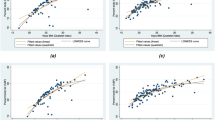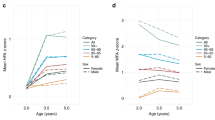Abstract
Background/objectives:
Adiposity rebound (AR) is defined as the nadir or the inflexion point of body mass index (BMI) percentiles between the age of 3 and 7 years. An early rebound is seen as a risk of obesity and, thus, AR is considered as a suitable time period for prevention. As BMI does not reflect body composition, we aimed to examine the rebounds of fat mass index (FMI) and fat-free mass index (FFMI) together with BMI.
Subjects/methods:
Cross-sectional data of 19 264 children aged 3–11 years were pooled from three German studies (Kiel Obesity Prevention Study, the project ‘Better diet. More exercise. KINDERLEICHT-REGIONS’ and regular examinations of Jena children). Height and weight were measured. Fat mass (FM) and fat-free mass (FFM) were obtained from bioelectrical impedance analysis and analysed using a population-specific algorithm. Percentiles of BMI, FMI and FFMI were constructed by the LMS method.
Results:
Both BMI and FMI percentiles showed a rebound, whereas FFMI percentiles steadily increased with age. On P90, FMI rebound was about 1.6–1.8 years later compared with that of BMI, that is, at ages 4.2 years (BMI) and 5.8 years (FMI) in boys and at 4.2 years (BMI) and 6.0 years (FMI) in girls. At AR, the slope of the BMI-P90 was explained by increases in FFMI rather than FMI. By contrast, at FMI rebound, the slope of BMI was strongly related to FMI.
Conclusions:
BMI rebound does not equal the rebound of FM. At AR, the slope in BMI is determined by the increase in FFMI. AR should be defined as FMI rebound rather than BMI rebound.
This is a preview of subscription content, access via your institution
Access options
Subscribe to this journal
Receive 12 print issues and online access
$259.00 per year
only $21.58 per issue
Buy this article
- Purchase on Springer Link
- Instant access to full article PDF
Prices may be subject to local taxes which are calculated during checkout


Similar content being viewed by others
References
Cole TJ . Children grow and horses race: is the adiposity rebound a critical period for later obesity? BMC Pediatr 2004; 4: 6.
Rolland-Cachera MF, Deheeger M, Bellisle F, Sempe M, Guilloud-Bataille M, Patois E . Adiposity rebound in children: a simple indicator for predicting obesity. Am J Clin Nutr 1984; 39: 129–135.
Rolland-Cachera MF, Deheeger M, Guilloud-Bataille M, Avons P, Patois E, Sempe M . Tracking the development of adiposity from one month of age to adulthood. Ann Hum Biol 1987; 14: 219–229.
Rolland-Cachera MF, Deheeger M, Maillot M, Bellisle F . Early adiposity rebound: causes and consequences for obesity in children and adults. Int J Obes (Lond) 2006; 30 (Suppl 4), S11–S17.
Taylor RW, Williams SM, Carter PJ, Goulding A, Gerrard DF, Taylor BJ . Changes in fat mass and fat-free mass during the adiposity rebound: FLAME study. Int J Pediatr Obes 2011; 6: e243–e251.
Campbell MW, Williams J, Carlin JB, Wake M . Is the adiposity rebound a rebound in adiposity? Int J Pediatr Obes 2011; 6: e207–e215.
Taylor RW, Goulding A, Lewis-Barned NJ, Williams SM . Rate of fat gain is faster in girls undergoing early adiposity rebound. Obes Res 2004; 12: 1228–1230.
Williams SM, Goulding A . Patterns of growth associated with the timing of adiposity rebound. Obesity (Silver Spring) 2009; 17: 335–341.
Danielzik S, Pust S, Landsberg B, Müller MJ . First lessons from the Kiel Obesity Prevention Study (KOPS). Int J Obes (Lond) 2005; 29 (Suppl 2), S78–S83.
Müller MJ, Asbeck I, Mast M, Langnäse K, Grund A . Prevention of obesity — more than an intention. Concept and first results of the Kiel Obesity Prevention Study (KOPS). Int J Obes Relat Metab Disord 2001; 25 (Suppl 1), S66–S74.
Würbach A, Zellner K, Kromeyer-Hauschild K . Meal patterns among children and adolescents and their associations with weight status and parental characteristics. Public Health Nutr 2009; 12: 1115–1121.
Plachta-Danielzik S, Gehrke MI, Kehden B, Kromeyer-Hauschild K, Grillenberger M, Willhöft C et al. Body fat percentiles for German children and adolescents. Obes Facts 2012; 5: 77–90.
Cole TJ, Bellizzi MC, Flegal KM, Dietz WH . Establishing a standard definition for child overweight and obesity worldwide: international survey. BMJ 2000; 320: 1240–1243.
Rigby RA, Stasinopoulos DM . Generalized additive models for location, scale and shape. Appl Statist 2005; 54: 507–554.
Cole TJ, Green PJ . Smoothing reference centile curves: the LMS method and penalized likelihood. Stat Med 1992; 11: 1305–1319.
Royston P, Wright EM . Goodness-of-fit statistics for age-specific reference intervals. Stat Med 2000; 19: 2943–2962.
van Buuren S, Fredriks M . Worm plot: a simple diagnostic device for modelling growth reference curves. Stat Med 2001; 20: 1259–1277.
Bhargava SK, Sachdev HS, Fall CH, Osmond C, Lakshmy R, Barker DJ et al. Relation of serial changes in childhood body-mass index to impaired glucose tolerance in young adulthood. N Engl J Med 2004; 350: 865–875.
Eriksson JG, Forsen T, Tuomilehto J, Osmond C, Barker DJ . Early adiposity rebound in childhood and risk of type 2 diabetes in adult life. Diabetologia 2003; 46: 190–194.
Wadsworth M, Butterworth S, Marmot M, Ecob R, Hardy R . Early growth and type 2 diabetes: evidence from the 1946 British birth cohort. Diabetologia 2005; 48: 2505–2510.
Hughes AR, Sherriff A, Lawlor DA, Ness AR, Reilly JJ . Incidence of obesity during childhood and adolescence in a large contemporary cohort. Prev Med 2011; 52: 300–304.
von Kries R, Beyerlein A, Müller MJ, Heinrich J, Landsberg B, Bolte G et al. Different age-specific incidence and remission rates in pre-school and primary school suggest need for targeted obesity prevention in childhood. Int J Obes (Lond) 2012; 36: 505–510.
Taylor RW, Grant AM, Goulding A, Williams SM . Early adiposity rebound: review of papers linking this to subsequent obesity in children and adults. Curr Opin Clin Nutr Metab Care 2005; 8: 607–612.
Stolzenberg H, Kahl H, Bergmann KE . [Body measurements of children and adolescents in Germany. Results of the German Health Interview and Examination Survey for Children and Adolescents (KiGGS)]. Bundesgesundheitsblatt Gesundheitsforschung Gesundheitsschutz 2007; 50: 659–669.
Johnson W, Soloway LE, Erickson D, Choh AC, Lee M, Chumlea WC et al. A changing pattern of childhood BMI growth during the 20th century: 70 y of data from the Fels Longitudinal Study. Am J Clin Nutr 2012; 95: 1136–1143.
Clasey JL, Bradley KD, Bradley JW, Long DE, Griffith JR . A new BIA equation estimating the body composition of young children. Obesity (Silver Spring) 2011; 19: 1813–1817.
Montagnese C, Williams JE, Haroun D, Siervo M, Fewtrell MS, Wells JC . Is a single bioelectrical impedance equation valid for children of wide ranges of age, pubertal status and nutritional status? Evidence from the 4-component model. Eur J Clin Nutr 2013; 67 (Suppl 1), S34–S39.
Lohman TG . Applicability of body composition techniques and constants for children and youths. Exerc Sport Sci Rev 1986; 14: 325–357.
Schoeller DA . Hydrometry. In: Heymsfield SB, Lohman TG, Wang Z, Going SB eds Human Body Composition. Human Kinetics: Champaign, 2005, pp 35–50.
Kaminsky LA, Whaley MH . Differences in estimates of percent body fat using bioelectrical impedance. J Sports Med Phys Fitness 1993; 33: 172–177.
Vilaca KH, Ferriolli E, Lima NK, Paula FJ, Moriguti JC . Effect of fluid and food intake on the body composition evaluation of elderly persons. J Nutr Health Aging 2009; 13: 183–186.
Valdez R, Greenlund KJ, Wattigney WA, Bao W, Berenson GS . Use of weight-for-height indices in children to predict adult overweight: the Bogalusa Heart Study. Int J Obes Relat Metab Disord 1996; 20: 715–721.
Wells JC, Cole TJ . Adjustment of fat-free mass and fat mass for height in children aged 8 y. Int J Obes Relat Metab Disord 2002; 26: 947–952.
Acknowledgements
Kiel Obesity Prevention Study was supported by the Deutsche Forschungsgemeinschaft (DFG Mü 5.1–5), and Kompetenznetz Adipositas (Competence Network Obesity) was funded by the Federal Ministry of Education and Research (EpiGermany: FKZ: 01GI1121A and core domain body composition: FKZ: 01GI1125), WCRF and Wirtschaftliche Vereinigung Zucker. ‘Better diet. More exercise. KINDERLEICHT-REGIONS’ was funded by the German Federal Ministry of Food, Agriculture and Consumer Protection.
Disclaimer
The sponsors of the study had no role in study design, data collection, data analysis, data interpretation or writing of the paper. The corresponding author had full access to all the data in the study and had final responsibility for the decision to submit the paper for publication..
Author information
Authors and Affiliations
Corresponding author
Ethics declarations
Competing interests
The authors declare no conflict of interest.
Additional information
Contributors: SPD, ABW and MJM had the original idea; SPD, BK and MIG did the statistical analyses. SPD interpreted the data and wrote the final draft of the paper. CW and MG provided data of the project ‘Better diet. More exercise. KINDERLEICHT-REGIONS’ and contributed to the final draft of the paper. KKH provided data of the examination of Jena children and contributed to the final draft of the paper. SBH discussed the data and contributed to the final draft of the paper. MJM supervised the study, interpreted the data and wrote the final draft of the paper. All authors discussed the data and approved the final version of the paper. Guarantor: MJ Müller.
Rights and permissions
About this article
Cite this article
Plachta-Danielzik, S., Bosy-Westphal, A., Kehden, B. et al. Adiposity rebound is misclassified by BMI rebound. Eur J Clin Nutr 67, 984–989 (2013). https://doi.org/10.1038/ejcn.2013.131
Received:
Revised:
Accepted:
Published:
Issue Date:
DOI: https://doi.org/10.1038/ejcn.2013.131
Keywords
This article is cited by
-
Age at adiposity rebound and the relevance for obesity: a systematic review and meta-analysis
International Journal of Obesity (2022)
-
Body composition from birth to 2 years in term healthy Indian infants measured by deuterium dilution: Effect of being born small for gestational age and early catch-up growth
European Journal of Clinical Nutrition (2022)
-
Why do humans undergo an adiposity rebound? Exploring links with the energetic costs of brain development in childhood using MRI-based 4D measures of total cerebral blood flow
International Journal of Obesity (2022)
-
Trajectory of body mass index and height changes from childhood to adolescence: a nationwide birth cohort in Japan
Scientific Reports (2021)
-
Comparing BMI with skinfolds to estimate age at adiposity rebound and its associations with cardio-metabolic risk markers in adolescence
International Journal of Obesity (2019)



